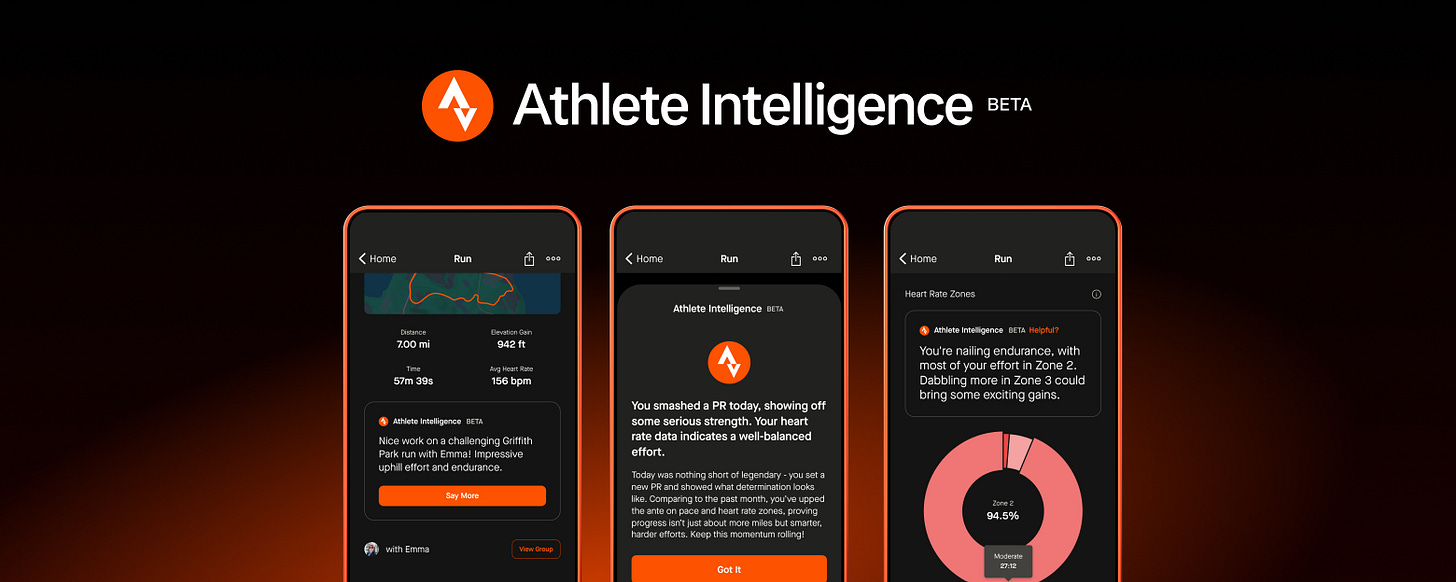✍️#8: Building STRAVA for the Creator Economy and Beyond
We've seen countless updates from STRAVA as subscription costs continue to rise, but what about building endurance's SOCIAL platform to include CREATORS?
HOW DID WE GET HERE?
I started to this of this concept when I wanted to apply to STRAVA back in 2023, but the fire was stoked again when listening to a recent episode of the Second Nature Podcast. In the episode, they discussed the recent changes at Outside and Sabrina Stanley signing with OnlyFans. How are they related? Both highlighted a changing strategy in the ecosystem of outdoor as all traverse the knife’s edge of authenticity and profitability.
STRAVA’S RECENT MOVES
Within recent years, we’ve seen STRAVA make big moves with feature rollouts, partnerships, and acquisitions. On the feature side:
On the partnerships and acquisitions side:
STRAVA’S BOTTOM LINE
3 Billion Activities in 2020 is head-turning, but how does it relate to business? STRAVA monetizes in several ways that we are aware of:
PARTNERSHIPS/CHALLENGES
In an ad-free platform, STRAVA gives brands a bite of the apple through its challenge feature. You may see a distance challenge (completing 26.2 miles in a month with Runna), or a time challenge (250 minutes in a month with The Feed), or a performance challenge (half marathon PR or top 3 effort with Brooks), or a consistency challenge (45 minutes of activity with Beats 45).
Brands not only can build awareness with their active user base (because you have to voluntarily opt in to join a challenge), but brands have the opportunity to plug their products/services within the challenge by offering things like 2 week free trial or raffling a pair of shoes. Further, they may be even able to convert by obtaining the email list of all participants who clicked and the ability to offer those participants a discount for purchase, gift with purchase, etc.
Reportedly: these partnerships can run a business between $30,000 - $200,000
SUBSCRIPTIONS
STRAVA runs a “freemium” model where users can join for free with limited features, but the platform aims to entice users to upgrade to paid with a slew of additional features. When you upgrade, you earn features like advanced training data, route suggestions, segment leaderboards, group challenges, subscriber perks, and access to Recover Athletics — just to name a few. This may explain why STRAVA has tried to add feature after feature to justify price hikes year over year.
DATA
Part of the “freemium” model is balanced with the amount of data farmed from users — the age old adage “when you don’t pay for the product, you are the product.” Through features like METRO and the YEAR IN SPORT reports, STRAVA has conceivably farmed enough data to attempt to sell it back to brands, municipalities, research groups, etc. However, in the quiver of monetization, this seems like the least adopted arm of the operation.
STRAVA FOR THE CREATOR ECONOMY
STRAVA undoubtedly has a captive user base that is diverse in their relationship to sport. STRAVA seems to address this with a range of features and brand activations — appealing to purists and achievers alike. HOWEVER, how many of these users are converting to paid? Strava’s revenue may be quite up and to the right, but developing the subscriber pipeline may be a way to further “de-risk” the business away from over-indexing on brand partnerships.
We’ve seen platforms like Instagram, Patreon, and OnlyFans build the ability for athletes and influencers to build their following and monetize it. Why can’t STRAVA? Think about it:
STRAVA has a niche user base that is passionate about their activity. Some may be purists who are inspired by the top athletes in sport. Some may be achievers who are inspired by influencers who help them feel seen in sport. STRAVA can provide ACCESS to these key individuals on the platform where they share the activity that brings them together. In a world where community is paramount and para-social relationships become increasingly volatile, why not give athletes and creators the ability to build community here?
Imagine a paywalled segment where athletes and creators could post the following:
pre-recorded educational content (how-to’s, training information, etc.) — even if its only early access before posting to YouTube/Spotify
pre-recorded entertainment content (vlogs of day in the life, podcasts, feature length films, etc.) — even if its only early access before posting to YouTube/Spotify
Live hosting — Ask Me Anythings
Exclusive Merch
One-on-one virtual coaching/counseling
In building an integrated arena for personalities, STRAVA may add even more value for brands. Brands can now have additional presence within this endemic social platform to speak through a lens of an athlete/creator, which runs parallel to a challenge. Think about how much more efficacious a challenge could be with the integration of a personality!
CREATING SUBSCRIBER VALUE THROUGH ADDITIONAL GAMIFICATION
Let’s go even further with gamification — the process of enticing users to engage MORE (and sometimes pay MORE) through competition. Imagine we removed subscriptions from the monetization model and used COINS/CREDITS.
Each user starts with a base amount of coins/credits. They can use those credits to access creator/athlete profile communities, buy exclusive merch, make wagers on the leaderboard of segments, etc. Each user can gain credits/coins through logging activities, achieving a milestone, completing a challenge, or purchasing more credits/coins.
The goal here is to incentivize the community in the way they already use social media at large and the way they use STRAVA instead of over-indexing on feature sets that they may not think they need or actually need for daily use.
CARVEOUTS
It’s important to note that this is a fantasy world situation. Pulling this off would involve massive restructures, server hosting costs, athlete/creator incentive plans, etc. But hey, it’s fun to dream!
SMALL BRAND MENTALITY SLINGSHOT
I’ve had the pleasure and privilege of connecting with individuals who aspire to build their careers in the outdoor industry and to flourish within it. In this segment, get to know and connect with them to slingshot their personal development and see what they’re up to!
Meet Aaron Ngor
Aaron has crafted a unique niche at the intersection of sports medicine, product development, and entrepreneurship. With 10+ years as a certified athletic trainer and performance therapist working with elite athletes, he's now applying his clinical expertise to solve technical performance challenges for athletes in specialized sports.
His recent pivot into product creation has landed him a role as a contracted consultant to develop lightweight, impact protective gear for b-boys and b-girls. Through his multidisciplinary approach combining clinical expertise with design thinking, Aaron analyzes movement patterns and translates athletes' needs into innovative solutions. His work spans from directing medical coordination for major breaking competitions for Red Bull BC One to designing technical apparel with thermoregulation features.
Aaron is always looking to connect with forward-thinking brands and fellow innovators in the athletic performance space to collaborate on products that enhance human potential.
Connect with Aaron on LinkedIn // Read his Substack: AWRX
Like what you’re reading? Buy me an NA Beer below to keep me fueled up!













I feel another avenue that Strava could dip into is training plans. Similar to how programs like TrainingPeaks allow people to create, market, and ultimately sell their training programs. This would make a way for creators and coaches to make some money and Strava could take a certain percentage from every sale as profit. It would cost very little for them for quite a lot of gain.
Plus with Strava adding more workout/activity analysis features into the app, I feel like this is the next logical step.
Great article! Last month I wrote an article which reviewed the State of Trail Running report and one of the striking points was that Strava was used by over 70% of trail runners. And yet, as you said so yourself, 90% of their revenue comes from subscriptions. It also seems that Strava does not seem very interested in diversifying their revenue because they have been acquiring companies which will allow them to add more to their premium offering. No storytelling, no patreon-style subscriptions, no pivot into training, nothing. If they just want to be the runner's social media that's fine (not all companies are meant to scale) but for most people their premium offering is not compelling, and they need to improve significantly to get a significant increase in subscribers. What is interesting, is that there are a lot of websites which utilise data from Strava to do all sorts of cool things (shoutout to Squadrats!) and I see no reason why strava wouldn't want to implement them themselves.
If you want to read my review of the Trail Running Report, including the piece on Strava, you can do so at https://bornonthetrail.substack.com/i/158282389/strava-dominates-but-fails-to-capitalise